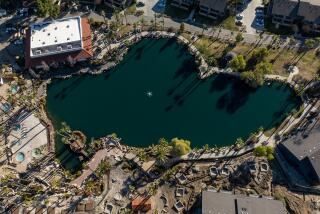It’s only natural: the quest for chemical-free swimming pools
- Share via
Chlorine has long been the industry standard to keep pool water clean and clear, but consumer demand for alternatives has prompted the emergence of new technologies, including the saltwater systems that came into vogue a few years ago and the copper-and-silver ionization and ozone-gas systems that are increasingly popular.
“I don’t like the stuff that goes into swimming pools,” said Philip Daughtry, a Topanga Canyon poet who often swims in the koi pond he refers to as his “backcountry swimming hole.” Daughtry’s swimming pond was constructed by Environmental Sculpturing in Topanga Canyon, the outfit that also helped to design and install the Santa Monica pond being built in a Zen-influenced, Minimalist style.
Natural swimming ponds take many shapes. Some look like traditional pools with poured concrete foundations, hard edges and straight lines. Others take forms that more closely mimic nature, with gently sloping and planted edges.
Natural swimming ponds are relatively new to the U.S., but more than 20,000 have been built globally, according to a spokesman for BioNova Natural Pools, a German company with North American headquarters in New Jersey and three natural swimming pools built or under construction on the East Coast. Next year BioNova will install what will be the first public natural swimming pool in the country at Webber Park in Minneapolis.
“A lot of people are interested in leading a chemical-free lifestyle. We’re not using any devices, sterilizers or chemicals of any kind,” said Alan Weene, spokesman for BioNova, which has partnerships to build natural swimming ponds in more than 30 countries. The BioNova system uses shallow- and deep-water plants in conjunction with filters to keep the water clear. The system only works to a temperature of 86 degrees, so it isn’t suitable for Jacuzzis.
BioNova pools, as well as those designed locally by Environmental Sculpturing, are biologically active. That means unlike chemically treated pools, which are sterile, natural swimming pools contain plants and beneficial microorganisms that outcompete algae and harmful bacteria for nutrients, leaving water safe for swimming. In these natural pools, water is circulated with pumps to prevent mosquitoes from laying eggs.
Although installation costs are slightly higher for a natural swimming pond compared with a traditional pool, the level of maintenance is roughly the same. Both types of pool require vacuuming and hand skimmers to pick off surface debris. Natural swimming ponds do not need biweekly visits from a pool professional to add chemicals, but they do require occasional weeding and replanting.
“One of the reasons why chlorine is the most popular swimming pool disinfectant is that it provides a long-lasting residual in the water,” said Mary Ostrowski, director of chlorine issues for the American Chemistry Council in Washington, D.C. In response to rising consumer interest, Ostrowski said, the group is working with an advisory council to provide information to consumers about various ways of keeping pools clean.
The number of systems in use continues to grow. Nature2 from Zodiac Pool Systems in Vista, Calif., dissolves traces of silver and copper into the water to disinfect it and prevent algae. The system, approved by the Environmental Protection Agency, allows pools to operate using just 0.5 part per million of chlorine, compared with the recommended 1 to 4 ppm for conventional pools. Wailani Natural Purewater Systems in Thousand Oaks also uses copper and silver ionizers, as well as an ozone gas generator that virtually eliminates the need for chlorine.
Corrected: An earlier version of this story said the American Chemistry Council is working with an advisory group to reduce chlorine use. It is not working to reduce chlorine use but rather to provide consumer information about all pool disinfection options.






